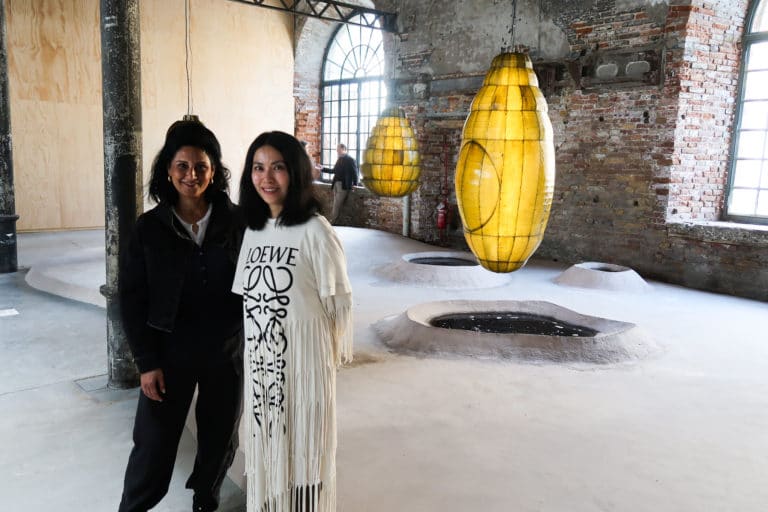The Bagri Foundation is pleased to shed more light on a new commission by Korean American artist Anicka Yi which we supported at the 58th International Art Exhibition – La Biennale di Venezia. The special project is presented in two parts, titled Biologizing the Machine (terra incognita) and Biologizing the Machine (tentacular trouble) and is showing until 24 November.
In Biologizing the Machine (tentacular trouble), the artist innovatively uses a stretched leather-like kelp to create hanging incandescent sculptures that conjure up images of organisms such as human organs and insect eggs through chrysalis-like pods within which animatronic insects flutter about. In Biologizing the Machine (terra incognita), Yi uses soil from Venice combined with a bacteria that emits a specific smell, akin to the algae-like smells of the canals in Venice. The hanging acrylic panels change colours over time depending on the AI controlled temperature, light and water level. More details about the work can be found here.
Anicka is particularly interested in the overlap between art and science. In her work she continuously explores ways in which art can be a useful tool for communicating the complex theories behind biology, anthropology, neurology, environment, technology and artificial intelligence. She will be in conversation with the curator of the Venice Biennial, Ralph Rugoff, and the Director of the Berggruen Institute Tobias Rees on 28 September at the RCA. Click here to book your free ticket.
The team and trustees at the Foundation were drawn to the work because of its interdisciplinary nature, bringing together art and science and exploring art’s role in representing the world around us, and its potential future. We were keen to further explore her works at the Biennale and unpack their complexities so our Head of Arts, Chelsea Pettitt, had a conversation with Anicka.
CP: You stated in your MOMA interview* earlier this year that ‘we need new ideas. We need a new vocabulary if we’re talking about our reality and where we want to go with it.’ There are many new ideas being explored in your work for Venice, both universal, but also local. Can you talk a little bit about the new realities you are exploring in Biologizing the Machine?
AY: With both Biologizing the Machine (terra incognito and tentacular trouble) I wanted to focus on the realities of ‘Biologizing the Machine’, considering the sensorium of the machine and its susceptibility to biological infiltration and hybridization. The broader thesis here is about the evolutionary transformation of the human and its companion species in the face of radical environmental and technological change. These are the new realities our civilization is dealing with which is why this work explores how synthetic biology, artificial intelligence, and rapid climate change disrupt conventional human notions of autonomy, individuality, and even basic survival.
CP: You’ve been working with the concept of smell and artificial intelligence (AI) for a number of years now. And Biologizing the Machine (terra incognita) also engages with this idea. Have you noted any progress or change in our understanding of olfaction (the sense of smell) or AI’s increased recognition of smell? Has the experiment here in Venice, which you call a ‘state of agitated symbiosis’ worked as you expected?
AY: My work in olfaction has always anticipated technological progress which is why I follow very closely any AI developments in relation to smell. There are engineers who are trying to train AI to smell odors but it’s very challenging as we don’t know much about how scent receptors work but that hasn’t stopped some MIT scientists from replicating artificial scent receptors in order to train a machine how to smell. The implications for this could mean that your smart phone could detect you have skin cancer since a lot of cancer has a distinct odor. The experiment in Venice has yielded varying results. The receptors installed in the piece were not strong enough to detect the subtle shifts in the bacterial growth so in the end we didn’t get the robust interaction as I’d hoped. In the future I would work with more powerful receptors for a project like this.
CP: Was there any particular experience, perhaps with a scientist or in your research, that sparked your interest in the algae kelp and its various uses as seen in Biologizing the Machine (tentacular trouble)? Did you have an immediate vision for the kelp as to how it could be used?
AY: I’m now called an algae evangelist due to my fervent belief in the powers of algae. I first became interested in algae a few years ago from a stark visual that possessed me, it was of a lamp made from kelp. Since that initial inspiration my studio has done a deep research dive into all manners of algae production and utility. Here’s a little inventory on the radical properties of algae: it’s largest biomass on the planet, supplies us with the oxygen we need to breathe/survive, doesn’t need arable land to grow, great potential for biofuel and biopolymer, algae is shape shifting complex organism- simultaneously bacteria, superfood, hybrid animal in case of Elysia Chlorota and certain species of frogs, etc. I could go on and on!
CP: You mentioned before that ‘art can actually invent tools and art can also push technology in ways that are completely unreasonable. We ask for the impossible things, the things that you’re not supposed to think.’ What do you think are the implications of the work you are doing? Or perhaps more accurately, what do you hope are the implications of the art you make?
AY: What I do is a kind of philosophy by a different means. What I hope that my work can do is converge art, philosophy and engineering, by collaborating with other disciplines I hope that the work we create is inseparably intermingled. My wish is to turn AI and biotech labs into philosophy laboratories by merging these different disciplines to underscore the necessity for a new kind of philosophy that must be forged together with these areas of technological disruption.
CP: I understand that you read a lot of non-fiction, especially about scientific theories. Do you feel pressure to look beyond modern-day problems to consider what’s next?
AY: I do read a lot of non-fiction but also fiction which can so poetically weave multiple narratives and scientific theories into complex world views which is incredibly inspiring for me. I feel compelled to access an omni directional relationship to the present as we look toward the near future. Historical precedents and patterns is a good place to begin when thinking about “what’s next” however, I would caution that we really can’t know what the future contains. With the acceleration of technology, it’s impossible to predict what kind of world we will find ourselves in 20-50 years. One could predict more accurately during medieval times as the pathway to significant change has been slow, due to a lack of centralized information distribution, but now it’s very difficult to know what our future will contain.
CP: Thinking about the near future, what are the next pressing matters that you want to explore through your work?
AY: The next pressing matter would be to level up on the stakes of the evolutionary transformation of the human. To further explore ideas of the machine sensorium, the machine microbiome, and the concept of artificial physical intelligence. To question the notion of intelligence as abstracted from the body, the concept of artificial general intelligence (AGI). Instead, I would posit robots in the world, relating and responding to the world through their particular robot body and sensorium, their sense of artificial physical intelligence (API). API is about letting intelligence emerge from being a body in the world, from the senses, by way of learning. If one approaches intelligence in terms of API, intelligence ceases to be about control and comes into view as relational navigation, as being part of a world that is bigger than any individual underlying system.
More details about Biologizing the Machine can be found on our projects page here.
*Read the full MOMA interview here


